How to Select the Best Weather Radio for Your Needs
Selecting the right weather radio is easy, once you know how the service works and which radio features are the most useful.
Have you ever been directly affected by severe weather or any civil emergency? Did you have enough warning to protect yourself, your family, and your property in reasonable time?
Did you get reliable information during the course of the event, including advice as to when the emergency was over?
Or are you just interested in observing the more interesting types of weather, either using a home weather station, or out of general interest, and would like to be informed when something is in the air?
If you answered yes, or even maybe, to any of those questions, you probably should get your own Weather Radio. If you live in an area likely to be affected by hurricanes, severe storms or tornadoes, a Weather Radio should be the first item in your emergency kit.
What is a Weather Radio?
There are two answers to that question.
Firstly, Weather Radio is a service provided by NOAA, the National Oceanic and Atmospheric Administration, a Federal Government agency. For more details go to the Weather Radio Service page. It is a dedicated radio network which provides weather information routinely, and alerts when necessary. The warnings are provided by the Emergency Alert Service (EAS) and include all forms of weather warnings, plus alerts on civil and other natural emergencies such as hazardous material spills, fires, law enforcement warnings, and even instances of child abduction.
To make sure of clear reception, the warnings are broadcast on frequencies away from the range of normal AM/FM radio, so a special type of radio is needed to receive them. And that brings me to the second answer...
Secondly, a Weather Alert Radio is a receiver designed to pick up NOAA broadcasts from any one of the seven VHF frequencies used for warnings. The radio receivers may be restricted to reception of the weather alert frequencies (between 162.40 and 162.55 MHz), or they may be AM/FM radios with an extended range to pick up the NOAA frequencies.
Either way, they will have an inbuilt function which automatically switches the radio from standby mode to active whenever a warning is received.
Features
Weather radios are not your standard background noise maker - they are designed to provide information about events that may directly affect you, so they need to be reliable and be able to get your attention when necessary.
Good weather alert radios will have all these features;
- A strong alarm tone - much louder than the normal broadcast level.
- Good reception of your local NWR transmitter
- Access to SAME (Specific Area Message Encoding). You only need to hear warnings about emergencies that may affect you. SAME lets you program your radio so that only alerts from counties or parts of counties in your local area will be broadcast.
- Both AC and battery power sources. Battery life should be as long as possible - many emergencies may be accompanied by a loss of power and battery operated radio may be your only source of information. An alternative is a hand cranked radio, where you can generate enough charge in the batteries to keep reception going for as long as necessary.
Weather radios by definition must all have a standby facility and access to all seven NOAA channels. This shouldn't be a problem with current models sold as weather or public alert radios, but I guess it wouldn't hurt to check.
They are widely available from electronics retailers, but Amazon and eBay are always worth checking Another good online source is Ambient Weather. More about pricing can be found at the end of this page.
Selecting a Weather Radio
Weather radios come in four forms - Portable and Desktop, and with or without SAME. SAME allows you to restrict the areas you will receive emergency alerts from to those near where you live - for more information visit the Weather Radio Service page.
With two exceptions, I can't see much point in buying an Emergency Alert Radio without SAME. By selecting the counties you need to hear about, you will eliminate false alarms.
However a car radio which would receive the NOAA frequencies could be very useful at times - they aren't standard in most vehicles but are available. One alternative is CB radio, and another is to take a portable weather radio with you.
Secondly, there are many occasions when access to alerts by users of two way radios is important if not essential. Midland, Audiovox, Motorola and Uniden all make two ways with access to the weather alert system.
Portables
Portable or Pocket Weather Radios are small and easy to carry around with you while away from home, and are particularly valuable at remote work locations or if you are camping. Hand cranked radios, where you can provide extra power when the batteries start to die by turning a handle for a minute or two, are a variety of portable or pocket radios.
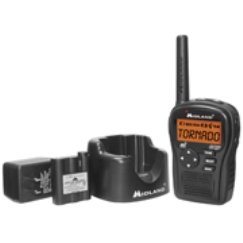
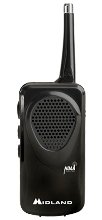
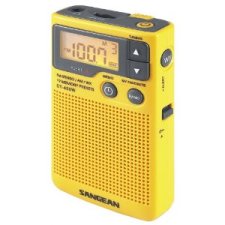
Manufacturers of portables include Sangean and Midland. Of these, the Midland HH54VP2 comes with SAME, while the Midland HH50 and the Sangean DT-400W do not. Follow the links for comprehensive reviews of these excellent weather radios
The sturdy little Sangean DT-400W Pocket Weather Alert Radio and the Midland HH54VP2 Pocket Weather Alert Radio
and the Midland HH54VP2 Pocket Weather Alert Radio shouldn't cost any more than $50.00, while the Midland HH50
shouldn't cost any more than $50.00, while the Midland HH50 can be found at around the $20.00 mark. SAME is an advantage if you intend to only have one weather radio at home, but these are really designed to be portable, and will pick up the clearest weather radio signal in the area.
can be found at around the $20.00 mark. SAME is an advantage if you intend to only have one weather radio at home, but these are really designed to be portable, and will pick up the clearest weather radio signal in the area.
Hand Cranked Radios
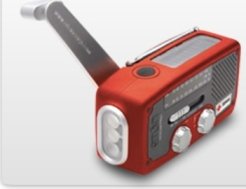
These are the true fail safe radio. Batteries running low? Just turn the crank handle for a minute or two to provide up to an hour's extra reception. A good hand cranked weather radio is probably the first thing you should put into your emergency kit.
A well designed example is the Eton FR160 Hand Cranked Radio , which includes AM/FM reception as well as full weather functions, and can also be recharged through a solar cell which forms part of the radio. It doesn't include SAME but will find the most powerful weather radio signal in the surrounding area.
, which includes AM/FM reception as well as full weather functions, and can also be recharged through a solar cell which forms part of the radio. It doesn't include SAME but will find the most powerful weather radio signal in the surrounding area.
Desktops
A wide range of models ensures you'll have no trouble finding a weather radio to suit your needs. The major manufacturers are Midland, First Alert, Reecom and Sangean, all with plenty of experience in this field.
You can expect to pay a little more for desktops compared to a portables, with most manufacturers suggesting a retail price of between $59.95 and $79.95. Once again, you will be able to find considerable discounts from internet retailers, and don't forget eBay for both new and used models.
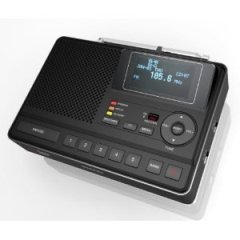 The main differences between models are whether they are dedicated to the weather radio network or can also pick up AM/FM stations, and in the number of counties that can be programmed under the SAME system. Some of the more expensive radios claim greater ease in programming the counties you have selected, so if you can't find an eleven year old genius to do it for you, the Sangean CL-100 is not only easy to program, but is a very good weather radio combined with a fine AM/FM clock radio - see more below.
The main differences between models are whether they are dedicated to the weather radio network or can also pick up AM/FM stations, and in the number of counties that can be programmed under the SAME system. Some of the more expensive radios claim greater ease in programming the counties you have selected, so if you can't find an eleven year old genius to do it for you, the Sangean CL-100 is not only easy to program, but is a very good weather radio combined with a fine AM/FM clock radio - see more below.
Three models stand out, mainly because of their usefulness in times of no emergency, where they function as basic clock radios. All have AM/FM, which is overridden when an alert is broadcast. You can find comprehensive reviews on them at my blog, Weather Radios Guide .
Especially attractive is the ability to delete warnings that are not relevant to you, such as flood warnings when you live in a flood free area. You can also ensure less interrupted sleep by eliminating the watch notices, so that the alert will only sound if a warning has been issued. These weather alert radios are;
- The Sangean CL-100 has a very clear LCD screen, and is also a very good clock radio with AM and FM reception. Up to 25 counties can be programmed quite easily, and the LCD is color coded to show the type of alert. It will also switch off at the end of the broadcast alert message. It is powered by 4AA batteries or an AC Adapter. You can get a Sangean CL-100 Weather Alert Radio
 for around $70.00 by following this link.
for around $70.00 by following this link.
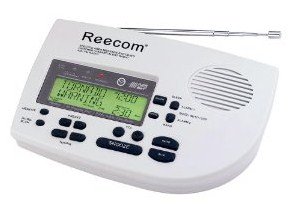
- The Reecom R-1650 also costs around $70.00 and will handle 20 counties or part counties. It has an AC adapter and 4 AA batteries, a reasonable sized LCD display for alert identification. The Reecom R-1650 Weather Alert Radio
 also identifies the scale of the alert - statement, watch or warning.
also identifies the scale of the alert - statement, watch or warning. But if you are just looking for a top quality weather radio without the AM/FM band, the Reecom R-1630 is otherwise identical to the R-1650, but at around one third less cost. You'll find it by clicking on the R-1650 link above.
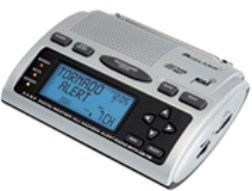
- The Midland WR-300. Listed at $79.95, but often much cheaper, the Midland WR-300
 weather radio has everything the other two have, plus a 30 county memory (probably more than either of us would ever need, but it might be handy when traveling).
weather radio has everything the other two have, plus a 30 county memory (probably more than either of us would ever need, but it might be handy when traveling). You can select which the type of warning you want to hear, and also the type of warning signal - siren, tone or voice. The screen will display three lines describing the alert, although it can be a little hard to see if you are not directly above it. Unlike the other two, the Midland 300R does not recognise the End of Message signal, and will contiune to repeat the message for five minutes or until it is turned off manually.
It can be powered by AC, 4AA batteries, or 10-12v DC, and also has outlets to link it to accessory alarm devices like strobe warning lights or pillow vibrators.
The Midland WR-300 has been around for a while and does not have the same range of features as the other two newer models, while they are also better quality clock radios. There also seem to be more reports of quality control problems in recent years, so perhaps it is getting close to needing a makeover.
The Midland WR-300 Weather Alert Radio is still the most popular desktop weather radio and is a little cheaper than its main competitors. Follow the link to see what its buyers think and to get a good price.
is still the most popular desktop weather radio and is a little cheaper than its main competitors. Follow the link to see what its buyers think and to get a good price.
Click Here For Your Free 20 Page Report on Solving
the Most Common Weather Station Problems
Something A Little Different.
Oregon Scientific, well known for a huge range of weather stations, also produce weather or public alert radios. They haven't had the happiest time with them, and went through a major recall when several of their radios were unable to receive the NOAA frequencies in some parts of the US.

Hopefully that's all in the past, and new models have been produced, including a combination weather radio and temperature station with basic weather forecasting abilities. This is the Oregon WRB603 , which is based on the Oregon WR602N Weather Alert Radio.
, which is based on the Oregon WR602N Weather Alert Radio.
Having temperature and humidity information available to you from an outside sensor, together with pressure data from an inbuilt barometer, adds another dimension to the weather experience, particularly during the stormy part of the year.
The WR602N is a basic portable weather radio which uses the cradle as a charger, although it can be used as a standalone receiver, including when you travel. Its travel mode homes in on the strongest signal from local emergency alert transmitters, but it is easily programmable with up to 9 county locations using the SAME system.
The WRB603 costs around $80.00 and the WR602N a bit over half that. Maybe a bit over priced, and not as good value as some of the other weather alert radios described earlier, but well presented and capable of providing basic weather information and timely warnings. You can pick one up from Oregon's store or from Amazon at a good price.
at a good price.
Conclusions
While some weather alert radios have a few more options than others, any of the brands mentioned will have a model that is more than adequate in an emergency situation, although it would be prudent to have plenty of batteries on hand in case of long power interruptions. The recommended models have just a little extra in their favour.
Finally, the backup to weather radio if you are out of range or away from your normal environment is the warning service on the internet through any of the weather channels.
Good luck with your selection, and I hope you don't need to use it too often.
The
Severe Weather Page
includes information and links to articles on the types of weather that are likely to result in weather watches or warnings.
This link will take you back to the Top, or, when you're ready, here's how to return to the Home page.
But just before you move on...
You may be interested to know that you can find out more about weather and home weather stations by receiving our newsletter ,"Watching Weather". It's published more or less weekly, and apart from tips on how to use your weather station and understand what it's telling you about the weather around you, it also covers many other weather related topics.
If this sounds interesting, just add your name and email address to the form below. When you join, you'll also receive, totally free, a 20 page guide to setting up and trouble shooting problems in home weather stations.
And I promise that you won't get spammed, and that your sign up details will remain totally confidential.
Sign up now and receive your first issue almost immediately.
ADD TO YOUR SOCIAL BOOKMARKS:  Blink
Blink  Del.icio.us
Del.icio.us  Digg
Digg Furl
Furl  Google
Google  Simpy
Simpy  Spurl
Spurl  Technorati
Technorati  Y! MyWeb
Y! MyWeb
.
*Product links and pricing. The products I mention are, in my opinion, the best of the range in each category. But this doesn't mean they are just what you are looking for, and it is always worth following the link to the manufacturer's page.But don't buy from there - in almost all cases muchbetter prices are available from both shopfront and internetbased retailers. At all times eBay and Amazon are worthchecking out, and you will notice many of the links go toAmazon. Amazon has built a very sound reputation for customerservice, given the huge amount of business that passes throughtheir website, and many products are accompanied by cleardescriptions, alternatives, and reviews from customers. Thesecan be very helpful, and I shop at Amazon myself.
But prices can change very quickly there, so if you have madeup your mind on a product and you see a good price at Amazon or eBay, grab it before it goes.
Where possible, I provide links to other retailers where their prices are competitive. Some may be better than they seem ifthe prices include delivery and, where needed, batteries - check the terms they offer.
Finally, I stand to make small commissions on some of the productsI recommend. A lot of work goes into building and maintaining asite like this, and I am not ashamed if I recoup some of the costs,and even make a little money on top.
That being said, I will and do recommend sellers where I will notmake anything for myself. One of these is Ambient Weather, a useful retail site with good supporting information. But if you visit there, don't forget to come back!
Last update 05/25/2011


 These are the true fail safe radio. Batteries running low? Just turn the crank handle for a minute or two to provide up to an hour's extra reception. A good hand cranked weather radio is probably the first thing you should put into your emergency kit.
These are the true fail safe radio. Batteries running low? Just turn the crank handle for a minute or two to provide up to an hour's extra reception. A good hand cranked weather radio is probably the first thing you should put into your emergency kit.




 The main differences between models are whether they are dedicated to the weather radio network or can also pick up AM/FM stations, and in the number of counties that can be programmed under the SAME system. Some of the more expensive radios claim greater ease in programming the counties you have selected, so if you can't find an eleven year old genius to do it for you, the Sangean CL-100 is not only easy to program, but is a very good weather radio combined with a fine AM/FM clock radio - see more below.
The main differences between models are whether they are dedicated to the weather radio network or can also pick up AM/FM stations, and in the number of counties that can be programmed under the SAME system. Some of the more expensive radios claim greater ease in programming the counties you have selected, so if you can't find an eleven year old genius to do it for you, the Sangean CL-100 is not only easy to program, but is a very good weather radio combined with a fine AM/FM clock radio - see more below.


